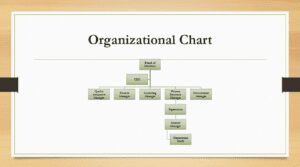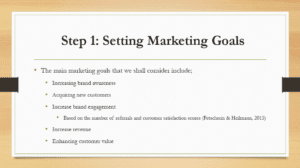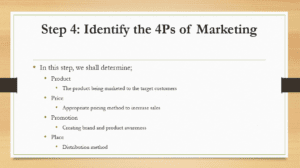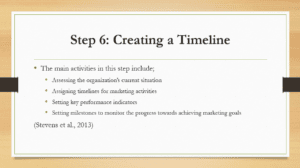Sport Management and Marketing Project
Hello. Welcome to today’s presentation on our organizational structure and marketing plan steps.
Our organizational structure focuses on assigning roles based on various specializations. According to Pedersen & Thibault (2021), specialization makes a sports organization horizontally or vertically different. In vertical differences, there are multiple layers in the organization, whereas, in horizontal differences, roles are specialized for specific people. In our organization, the quality assurance manager, finance manager, marketing manager, human resource manager, and procurement manager will directly report to the board of directors. The board will be at the top of the hierarchy, followed by the CEO. The supervisors, general manager, and department heads will report to the human resource manager.
The first step of our marketing plan is setting marketing goals. One of our main marketing goals is to increase brand awareness. The goal will be measured based on brand search volumes, website traffic, brand mentions, and new followers on social media platforms.
Contact us at eminencepapers.com for help on your assignment.
The second goal is acquiring new customers, which will be measured by evaluating the churn rate. The third goal is increasing brand engagement. According to Fetscherin & Heilmann (2015), brand engagement can be assessed based on the number of referrals and customer satisfaction scores. The fourth goal is to increase revenue, and the fifth is to enhance customer value, measured using customer feedback.
The second step of our marketing plan is analyzing the market environment. The main activities in this step include determining strengths, weaknesses, threats, and opportunities, identifying major competitors, identifying the company’s market position, identifying the company’s market share, and resolving customer demographics (Aghazadeh, 2016). The primary customer demographics that will be considered are age, income, and location.
The third step of our marketing plan is creating a marketing message. According to Mitterfellner (2019), the main activities in this step include classifying target customers based on their demographics, identifying the problems being experienced by the target market, presenting the solution the product offers to the problems being encountered by the target market, presenting the solutions to other people in a similar solution to evaluate their effectiveness, explaining what distinguishes the product from what is offered by competitors and aligning the marketing message with the organization’s values.
The fourth step of our marketing plan is identifying the 4Ps of marketing. In this step, we shall determine the product being marketed to the target customers, the appropriate pricing method to increase sales, how we shall create brand and product awareness, and the distribution method. The main pricing methods are value-based, competition-based, and cost-based (Schindler, 2011). Essentially, competition-based pricing includes getting prices based on the prices set by competitors. On the other hand, value-based pricing includes setting prices based on a product’s benefits to customers. Finally, cost-based pricing includes setting prices based on the business’s costs in developing the product.
The fifth step of our marketing plan is determining marketing tactics. The main marketing tactics that will be considered include digital and traditional marketing tactics. Digital marketing tactics include Search Engine Optimization, content marketing, email marketing, and social media marketing (Kaufman & Horton, 2014). Traditional marketing tactics include using newspaper ads and flyers.
The sixth step of our marketing plan is creating a timeline for our marketing activities. The main activities in this step include assessing the organization’s current situation based on company image, equity, and reputation, assigning timelines for marketing activities, setting key performance indicators, and setting milestones to monitor the progress towards achieving marketing goals (Stevens et al., 2013).
The seventh step of our marketing plan is creating the marketing budget. The main factors we shall consider in making the budget include customer base, competition, product substitutability, advertising frequency, stages in the product lifecycle, and marketing goals. According to Yadav (2022), the marketing budget should be flexible to accommodate any unexpected events that could affect the marketing activities.
The eighth step of our marketing plan is assigning tasks to the marketing team. The main tasks in marketing include building customer relationships by offering feedback to customers and addressing customer complaints, advertising through posting marketing ads on social media platforms and creating brochures and newspaper ads, and monitoring the effectiveness of marketing tactics by evaluating changes in sales and customer base (Brinker, 2016).
The ninth step of our marketing plan is implementing the marketing strategy. The company will implement the marketing strategy based on the customer buying cycle.
According to Young & Holland (2009), the customer buying cycle is the process customers follow before purchasing. It includes awareness, consideration, intent, purchase, and repurchase. Awareness includes realizing a problem that should be solved. Consideration includes reviewing options that offer a solution to the identified problem. Intent includes developing interest in one of the options that have been reviewed.
The tenth step of our marketing plan is measuring the effectiveness of the marketing strategies. The effectiveness of the marketing strategies will be measured by evaluating the long-term and short-term revenue generated by the marketing campaign, tracking the capital expenditures on every marketing channel, calculating customer lifetime value, calculating customer retention rates, and determining the number of new customers gained from the marketing campaign. According to Young & Holland (2009), customer lifetime value includes the average revenue generated from customers over the time they have a relationship with an organization or company.
Aghazadeh, H. (2016). Business environment and market analysis (BEMA) framework. Principles of Marketology, Volume 1, 249-289. https://doi.org/10.1057/9781137379320_7
Brinker, S. (2016). Hacking Marketing: Agile practices to make marketing smarter, faster, and more innovative. John Wiley & Sons.
Fetscherin, M., & Heilmann, T. (2015). Consumer brand relationships: Meaning, measuring, managing. Springer.
Kaufman, I., & Horton, C. (2014). Digital marketing. https://doi.org/10.4324/9781315879451
Mitterfellner, O. (2019). Creating the marketing message. Fashion Marketing and Communication, 60-79. https://doi.org/10.4324/9780429451591-4
Pedersen, P. M., & Thibault, L. (2021). Contemporary sport management (5th ed.). Human Kinetics.
Schindler, R. M. (2011). Pricing strategies: A marketing approach. SAGE Publications.
Stevens, R. E., Loudon, D. L., & Nykiel, R. A. (2013). Marketing your business: A guide to developing a strategic marketing plan. Routledge.
Yadav, N. (2022). Promotional budget. PHARMA MARKETING MANAGEMENT. https://doi.org/10.52458/9789391842666.nsp2022.eb.asu.ch12
Young, T., & Holland, J. R. (2009). Rethinking the sales cycle: How superior sellers embrace the buying cycle to achieve a sustainable and competitive advantage. Mcgraw-hill.
Čermák, P. (2015). Customer profitability analysis and customer lifetime value models: Portfolio analysis. Procedia Economics and Finance, 25, 14-25. https://doi.org/10.1016/s2212-5671(15)00708-x
ORDER A PLAGIARISM-FREE PAPER HERE
We’ll write everything from scratch
Question
Using the content from this unit, you will create a PowerPoint presentation that describes and explains a marketing plan for a product you wish to market. The product may have already been developed or one that you have created. The presentation will consist of a minimum of 11 slides, which does not include the title slide or reference slide.

Sport Management and Marketing Project
Create or locate a product you wish to market in your local area. Follow the order given below for organizing your PowerPoint slides. You are required to design at least one slide for each of the 10 steps listed for a marketing plan.
Slide 1: Title slide
Slide 2: Organizational chart: Your organizational chart should also explain organizational behaviour within the sports industry.
Slides 3–12: The 10 steps of the marketing plan: You must also relate the influence of marketing on sports management.
Slide 13: Reference slide
Be creative with your presentation. Make sure the font type, font size, and background used are legible for the reader. Feel free to include graphics to enhance your presentation. Include at least two sources in your presentation. Using speaker notes is optional. You will be expected to use APA Style citations and references for all sources used. APA formatting, however, is not necessary.















